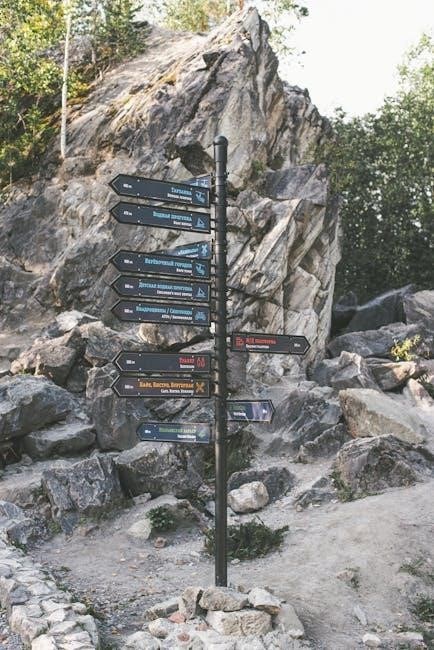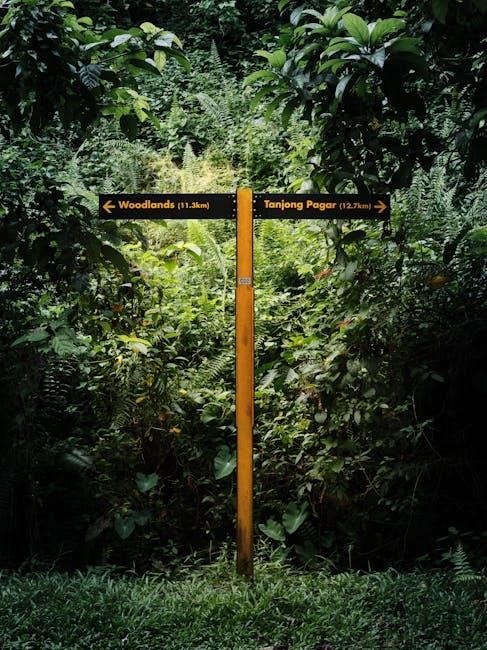The Trail Guide to the Body, 5th Edition, by Andrew Biel, is a comprehensive guide for locating muscles, bones, and ligaments. Published by Books of Discovery, it offers a hands-on approach to understanding human anatomy;
With updated anatomical terminology and over 1,400 illustrations, this spiral-bound textbook is an essential tool for students and professionals in massage, physical therapy, and related fields.

Overview of the Book
The Trail Guide to the Body, 5th Edition, authored by Andrew Biel, is a renowned textbook designed for hands-on learning of human anatomy. Published by Books of Discovery, it spans 504 pages, featuring over 1,400 detailed illustrations. The book focuses on the musculoskeletal system, covering 162 muscles, 206 bones, 33 ligaments, and 110 bony landmarks; Its clear, step-by-step approach guides readers through complex anatomical structures, making it an invaluable resource for students and professionals in fields like massage therapy, physical therapy, and chiropractic care. The 5th edition includes a 56-page appendix dedicated to trigger points and pain patterns, enhancing its practical applications for assessment and treatment. This comprehensive guide is both a classroom essential and a professional reference, providing a thorough understanding of the human body’s inner workings.
History and Evolution of the Trail Guide Series
The Trail Guide to the Body series, authored by Andrew Biel, has become a cornerstone in anatomy education since its inception. The first edition laid the groundwork as a practical guide for locating muscles, bones, and ligaments, catering to massage therapists and bodyworkers. Over the years, the series has evolved to meet the growing demands of the field, with each edition incorporating feedback from educators and practitioners. The 5th edition represents a culmination of this evolution, featuring updated anatomical terminology, expanded illustrations, and a deeper focus on musculoskeletal structures. By blending time-tested methods with cutting-edge research, the series has solidified its reputation as an indispensable resource for both students and professionals in the healing arts.
Target Audience and Purpose
The Trail Guide to the Body, 5th Edition, is designed for students and professionals in fields requiring a deep understanding of human anatomy, such as massage therapy, physical therapy, and bodywork. Its primary purpose is to provide a practical, hands-on guide for accurately locating muscles, bones, and ligaments. The book is particularly valuable for those needing to assess and treat musculoskeletal structures effectively. It serves as both an educational tool for classroom learning and a reference for clinical practice. Additionally, the workbook and posters complement the main text, aiding in self-study and exam preparation. This resource is indispensable for anyone seeking to master palpation skills and integrate anatomical knowledge into their work. Its clear, structured approach makes it a favorite among educators and practitioners alike.

Key Features of the 5th Edition
The 5th edition includes updated anatomical terminology, over 1,400 detailed illustrations, and comprehensive coverage of 162 muscles, 206 bones, and 33 ligaments, enhancing learning and practice.
Updated Anatomical Terminology
The 5th edition includes the latest anatomical terminology, reflecting current scientific consensus. This ensures accuracy and alignment with modern standards, aiding students and professionals in staying updated. The terminology updates are seamlessly integrated, maintaining clarity and consistency throughout the guide. This attention to detail enhances the learning experience, providing a reliable reference for hands-on practice. The updated terms are highlighted to facilitate easy identification, making the guide a valuable resource for those mastering musculoskeletal anatomy. This feature underscores the book’s commitment to excellence and relevance in the field of manual therapy and bodywork education.
Extensive Illustrations and Visual Aids
The 5th edition features over 1,400 detailed illustrations, providing a visual map of the human body’s musculoskeletal system. These visuals cover more than 162 muscles, 206 bones, 33 ligaments, and 110 bony landmarks, offering unparalleled clarity. The illustrations are designed to enhance learning, enabling users to identify and locate structures with precision. Each drawing is carefully labeled and cross-referenced, making it easier to understand complex anatomical relationships. The visual aids are complemented by clear, concise descriptions, creating a user-friendly guide for both students and professionals. This extensive use of visuals ensures that the Trail Guide to the Body remains a cornerstone for hands-on learning and practical application in manual therapy and bodywork education.
Comprehensive Coverage of Musculoskeletal Structures
The 5th edition provides an exhaustive exploration of the musculoskeletal system, detailing over 162 muscles, 206 bones, 33 ligaments, and 110 bony landmarks. This thorough coverage ensures that users gain a deep understanding of each structure’s location, function, and interconnections. The text is organized into clear, step-by-step trails, guiding readers through the body’s complex anatomy. By integrating detailed descriptions with practical applications, the book serves as an invaluable resource for both educational and clinical settings. Its focus on hands-on learning makes it ideal for students and professionals seeking to enhance their palpation and assessment skills, ensuring a comprehensive grasp of the human musculoskeletal system for effective treatment and analysis.

Muscle Anatomy and Localization
The guide provides a systematic approach to identifying muscles, emphasizing trigger points and pain patterns. It offers detailed maps for precise localization, aiding in effective assessment and treatment strategies.
Step-by-Step Guide to Muscle Identification
The Trail Guide to the Body, 5th Edition offers a clear, step-by-step approach to muscle identification, making complex anatomy accessible. Each muscle is detailed with its origin, insertion, and function, accompanied by precise illustrations to aid visualization. The guide emphasizes trigger points and referred pain patterns, crucial for accurate assessment. By breaking down the process into manageable steps, it empowers learners to confidently locate and understand musculoskeletal structures. This systematic method is particularly valuable for students and professionals in fields requiring manual therapy, ensuring a solid foundation for effective practice.
Common Trigger Point Locations and Pain Patterns
The Trail Guide to the Body, 5th Edition includes an extensive 56-page appendix dedicated to identifying trigger points and their associated pain referral patterns. This detailed resource covers over 100 muscles, providing clear descriptions of common trigger point locations and the pain patterns they produce. The guide helps practitioners understand how trigger points can mimic or exacerbate other conditions, ensuring accurate diagnoses and effective treatment plans. By linking anatomy to clinical presentation, it serves as an invaluable tool for massage therapists, physical therapists, and other healthcare professionals. This section enhances palpation skills and equips practitioners with the knowledge to address myofascial pain effectively, improving patient outcomes and treatment success.
Practical Applications for Assessment and Treatment
The Trail Guide to the Body, 5th Edition bridges anatomy and clinical practice, offering practical techniques for assessing and treating musculoskeletal conditions. It provides step-by-step guidance on palpation, enabling professionals to accurately identify muscles, bones, and ligaments. The book’s detailed maps of bony landmarks and trigger points aid in creating effective treatment plans. For instance, therapists can use the guide to locate and address trigger points linked to pain referral patterns. This hands-on approach enhances diagnostic accuracy and treatment outcomes, making it an essential resource for massage therapists, physical therapists, and chiropractors. The text also supports the integration of anatomical knowledge into real-world clinical scenarios, fostering a deeper understanding of the body’s structure and function. This practical focus ensures that professionals can apply the book’s insights directly to patient care.

Bone and Ligament Anatomy
The book provides a detailed exploration of the 206 bones and 33 ligaments, offering clear maps of bony landmarks and insights into ligament structure and function.
Detailed Maps of Bony Landmarks
The Trail Guide to the Body, 5th Edition includes detailed maps of 110 bony landmarks, providing a clear and precise guide for locating anatomical structures. These maps are designed to enhance understanding of the musculoskeletal system, making it easier for students and professionals to identify and assess bones and related structures. With 504 pages and 1,400 illustrations, the book offers a comprehensive visual approach to learning. The detailed maps are particularly useful for hands-on practitioners, such as massage therapists and physical therapists, who need to accurately locate bony landmarks for assessments and treatments. This feature, combined with updated anatomical terminology, ensures a thorough and accurate exploration of the body’s skeletal framework.
Understanding Ligament Structure and Function
The Trail Guide to the Body, 5th Edition provides a detailed exploration of ligament structure and function, covering 33 key ligaments in the human body. Ligaments, essential for joint stability and movement, are thoroughly explained to help practitioners understand their role in connecting bones and supporting musculoskeletal integrity. The book emphasizes how ligaments work in conjunction with muscles and bones to facilitate motion while preventing excessive joint mobility. This section is particularly valuable for physical therapists, massage therapists, and bodyworkers, offering insights into how ligaments contribute to posture, movement patterns, and overall musculoskeletal health. By integrating this knowledge, professionals can better assess and address injuries or imbalances related to ligamentous structures.
Integrating Bone and Ligament Knowledge in Practice
Integrating bone and ligament knowledge into practice is essential for effective assessment and treatment. The Trail Guide to the Body, 5th Edition provides detailed maps of bony landmarks and ligament structures, enabling professionals to better understand how these components interact. By identifying ligament attachments and their role in joint stability, practitioners can improve diagnostic accuracy and develop targeted treatment strategies. This knowledge is particularly useful for physical therapists, massage therapists, and bodyworkers, as it enhances their ability to address injuries and imbalances. The book’s comprehensive coverage of 206 bones and 33 ligaments offers a foundation for integrating this information into clinical practice, ultimately improving patient outcomes and advancing musculoskeletal care.

Palpation Techniques and Skills
The Trail Guide to the Body 5th Edition provides hands-on guidance for mastering palpation techniques, offering a step-by-step approach to accurately assess and treat musculoskeletal structures effectively.
Mastering Palpation for Accurate Assessment
Mastering palpation is a cornerstone of the Trail Guide to the Body, 5th Edition. This section provides a detailed, hands-on guide to developing the skills necessary for precise assessment.
Through step-by-step instructions and clear illustrations, readers learn to identify musculoskeletal structures, including muscles, bones, ligaments, and trigger points; The guide emphasizes proper hand positioning and pressure techniques.
Practical exercises and real-world applications help practitioners refine their palpation abilities, ensuring accurate diagnoses and effective treatments. This chapter is indispensable for professionals seeking to enhance their tactile assessment skills.
With a focus on anatomical accuracy, the guide bridges theory and practice, making it an invaluable resource for both students and experienced practitioners.
Best Practices for Effective Palpation
Effective palpation requires a combination of skill, attention to detail, and a thorough understanding of anatomy. The Trail Guide to the Body, 5th Edition, emphasizes proper hand positioning, controlled pressure, and sensitivity to tissue texture.
Practitioners are encouraged to use a systematic approach, starting with superficial structures before progressing to deeper tissues. This ensures a clear and accurate assessment.
The guide also highlights the importance of maintaining a relaxed and steady touch to avoid causing discomfort or tension in the client. By mastering these techniques, professionals can enhance their diagnostic accuracy and improve treatment outcomes.
These best practices are complemented by the book’s detailed illustrations and step-by-step instructions, making it an essential resource for refining palpation skills.
Common Challenges and Solutions in Palpation
Palpation can present challenges, such as accurately identifying deep tissues or distinguishing between similar structures. The Trail Guide to the Body, 5th Edition, addresses these issues by providing clear, step-by-step guidance and visual aids.
Practitioners often struggle with maintaining consistent pressure and avoiding anatomical confusion. The guide offers practical solutions, such as using bony landmarks as reference points and employing a systematic approach to tissue exploration.
Additionally, the text emphasizes the importance of client relaxation and proper hand positioning to enhance palpation accuracy. By addressing these challenges, the guide equips professionals with the skills needed for precise and effective assessments.
These strategies are further supported by the book’s detailed illustrations and hands-on exercises, ensuring mastery of palpation techniques.
Hands-On Exercises for Skill Development
The Trail Guide to the Body, 5th Edition, includes hands-on exercises designed to enhance palpation and anatomy skills. These exercises guide learners through step-by-step muscle identification, ensuring a thorough understanding of musculoskeletal structures.
The workbook accompanying the text features self-testing and homework exercises, allowing students to reinforce their knowledge. Practical drills focus on locating muscles, bones, and ligaments, while also addressing trigger points and pain patterns.
With clear instructions and visual aids, the exercises help develop precision and confidence in assessing and treating musculoskeletal systems. This interactive approach makes complex anatomy accessible, preparing students for real-world applications in their field.
By integrating these exercises, the guide ensures mastery of essential skills, making it an invaluable resource for both education and professional practice.

Trigger Points and Pain Patterns
Trail Guide to the Body, 5th Edition, includes a 56-page appendix detailing trigger point locations and pain referral patterns for over 100 muscles, enhancing understanding of musculoskeletal dysfunction.
Identifying and Addressing Trigger Points
Trail Guide to the Body, 5th Edition, provides detailed maps for locating trigger points across 100 muscles, linking each to specific pain referral patterns. This section aids professionals in accurately identifying these points through palpation and visual cues, ensuring precise treatment. By understanding the connection between trigger points and referred pain, practitioners can develop targeted therapies to alleviate discomfort and restore function. The guide emphasizes evidence-based methods, making it a valuable resource for both education and clinical practice in fields like massage therapy and physical medicine.
Understanding Pain Referral Patterns
The Trail Guide to the Body, 5th Edition, offers a detailed exploration of pain referral patterns, enabling practitioners to trace discomfort to its source. By mapping how pain radiates from trigger points to distant areas, the guide enhances diagnostic accuracy. This knowledge is vital for creating effective treatment plans, ensuring targeted therapies address both the trigger point and its referred pain. The text’s 56-page appendix dedicates extensive coverage to these patterns, providing clear visuals and descriptions for over 100 muscles. This resource empowers professionals to better understand the interconnectedness of musculoskeletal structures, improving outcomes in pain management and rehabilitation.
Integrating Trigger Point Therapy into Practice
The Trail Guide to the Body, 5th Edition, provides a comprehensive approach to incorporating trigger point therapy into clinical practice. By detailing the locations and pain referral patterns of over 100 muscles, the guide enables practitioners to identify and address trigger points effectively. The extensive 56-page appendix serves as a valuable resource for understanding how trigger points contribute to pain and dysfunction. This knowledge allows professionals to develop targeted treatment strategies, enhancing patient outcomes. The text also emphasizes the importance of combining trigger point therapy with other modalities for a holistic approach to care. With its clear, hands-on guidance, the book supports practitioners in mastering techniques that improve both assessment and treatment efficacy.

The Trail Guide to the Body Workbook
The workbook offers self-testing exercises and homework assignments, helping students master anatomical concepts and prepare for exams. It includes 230 pages of interactive learning tools.
Features and Benefits of the Workbook
The Trail Guide to the Body Workbook, 5th Edition, complements the textbook with 230 pages of interactive exercises. It includes self-testing tools and homework assignments to reinforce anatomical knowledge.
Designed for hands-on learning, the workbook helps students identify muscles, bones, and ligaments through structured activities. It also provides detailed review sheets and practice exams to prepare for national certifications.
Key benefits include enhanced retention of complex concepts, improved palpation skills, and a clearer understanding of musculoskeletal relationships. The workbook is ideal for both classroom use and independent study.
Self-Testing and Homework Exercises
The workbook offers diverse self-testing tools, allowing students to gauge their understanding of anatomical concepts. Interactive exercises include labeling diagrams, matching terms, and identifying structures from descriptions.

Homework assignments are structured to reinforce key topics, such as muscle identification, trigger points, and bony landmarks. These activities promote active learning and retention of complex material.
By engaging with these exercises, students can track their progress, address knowledge gaps, and build confidence in their ability to apply anatomical knowledge in practical settings.
Preparing for National Exams
The workbook is designed to help students prepare effectively for national exams, such as the Licensing Exam for Massage Therapists. It includes practice questions and case studies that simulate exam conditions.
Key areas of focus include muscle identification, trigger point locations, and palpation techniques. These exercises ensure students are well-versed in the content typically covered on certification tests.
By mastering the workbook’s materials, students can approach their exams with confidence, knowing they have a solid foundation in the anatomical knowledge required for professional success.

Additional Resources and Supplements
Supplement your studies with the Trail Guide to the Body 5th Edition Student Workbook and Muscles of the Human Body Posters for enhanced learning.
Additional online support and study materials are available to aid in mastering the content and preparing for exams.
Muscles of the Human Body Posters
The Muscles of the Human Body Posters are a valuable supplement to the Trail Guide to the Body 5th Edition. This set of three posters provides detailed, full-color illustrations of the major muscle groups, including their origins, insertions, and actions. Perfect for visual learners, these posters offer a clear and concise way to reinforce anatomical knowledge. The spiral-bound design ensures durability, making them ideal for classroom or clinic use. By visually mapping the musculoskeletal system, the posters enhance understanding of muscle function and palpation techniques. They are an excellent resource for students, therapists, and healthcare professionals seeking to deepen their familiarity with human anatomy. Use them as a study aid or reference tool to complement the textbook and workbook.
Online Support and Study Materials
The Trail Guide to the Body 5th Edition is supported by a range of online resources designed to enhance learning and retention. These include interactive quizzes, video tutorials, and downloadable study guides that complement the textbook and workbook. Students and professionals can access digital flashcards to review anatomical terms and musculoskeletal structures. Additionally, the online platform offers practice exams to help prepare for national certification tests. The website also features a community forum where users can discuss challenges, share tips, and connect with peers. These resources provide a comprehensive and engaging way to master the material, ensuring a deeper understanding of palpation techniques and anatomical concepts. They are accessible anytime, making them ideal for self-paced study and professional development.
Community and Professional Networking
The Trail Guide to the Body 5th Edition fosters a vibrant community through its online platform, where students and professionals can connect and share knowledge. This network provides opportunities for collaboration, offering forums for discussing challenging topics and exchanging best practices. Users can engage with educators and practitioners, gaining insights and advice to enhance their skills. The community also hosts webinars and workshops, led by experts in the field, to explore advanced techniques and industry trends. By fostering these connections, the platform supports continuous learning and professional growth, helping individuals stay updated on the latest developments in musculoskeletal anatomy and palpation. This collaborative environment is invaluable for both newcomers and seasoned professionals seeking to expand their expertise and network.
The Trail Guide to the Body, 5th Edition, is a transformative resource for anatomy education, offering precise guidance and visual tools that empower professionals and students alike.
Final Thoughts on the Trail Guide to the Body 5th Edition
The Trail Guide to the Body, 5th Edition, stands as a pinnacle of anatomical education, blending detailed illustrations with practical guidance to create an indispensable resource for professionals and students.
Its comprehensive coverage of musculoskeletal structures, including 162 muscles and 206 bones, ensures a thorough understanding of the human body. The inclusion of trigger point locations and pain patterns adds clinical relevance, making it a valuable tool for therapists and educators alike.
With its clear, step-by-step approach and updated terminology, this edition reinforces its reputation as a trusted companion for anyone seeking mastery in anatomy and palpation techniques.
Impact on Education and Practice
The Trail Guide to the Body, 5th Edition, has significantly influenced both education and professional practice in fields like massage therapy, physical therapy, and anatomy. Its clear, hands-on approach has made it a cornerstone in training programs, enabling students to master palpation skills and musculoskeletal anatomy effectively.
Professionals rely on its detailed illustrations and updated terminology to enhance their assessments and treatments. The book’s practical applications, such as trigger point therapy, have become integral to clinical workflows, improving patient outcomes and setting a new standard for anatomical understanding in healthcare.
Its impact extends beyond academia, supporting lifelong learning and skill refinement, making it an indispensable resource for both educators and practitioners.
Future Directions for the Series
The Trail Guide to the Body series is expected to continue its legacy of excellence by incorporating emerging technologies and educational advancements. Future editions may integrate interactive digital tools, such as 3D anatomical models, to enhance learning experiences.
Expansion into specialized areas, like sports-specific anatomy or pediatric musculoskeletal assessment, could further cater to diverse professional needs. The series may also explore global outreach, offering translations and region-specific content to meet the demands of an international audience.
With a focus on innovation and accessibility, the Trail Guide to the Body series is poised to remain a leading educational resource, bridging the gap between theoretical knowledge and practical application for future generations of students and practitioners.